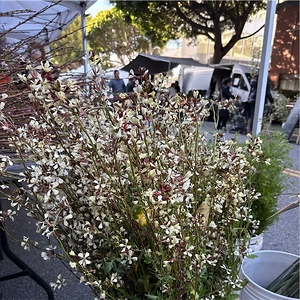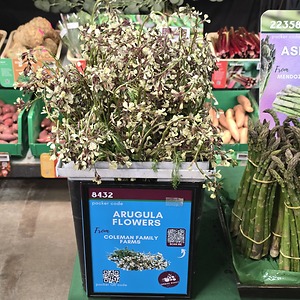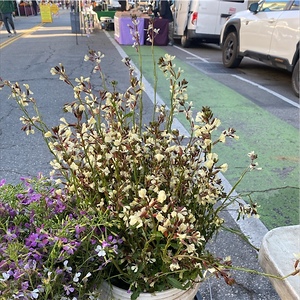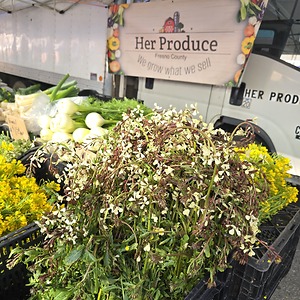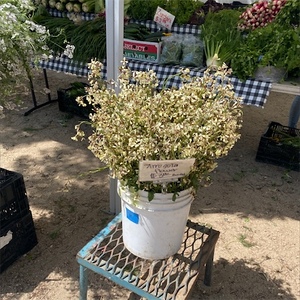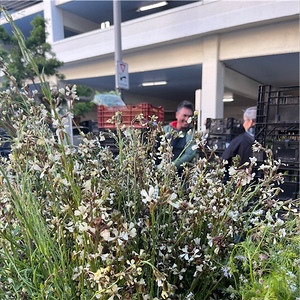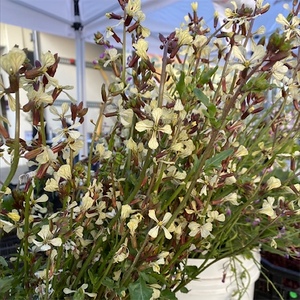


Arugula Blossoms
Estimated Inventory, 50 ct : 0
This item was last sold on : 06/17/24
| Fresh Origins | Homepage |
Description/Taste
Arugula blossoms are small flowers measuring approximately 2 centimeters in diameter. The flowers are attached to thin, crisp, and succulent stems and have a cruciform shape, meaning they have four symmetrical petals that form the shape of a cross. These petals differ in color depending on the variety of arugula, with domesticated arugula blossoms blooming white to cream-colored and wild arugula blossoms blooming yellow. Both types of flowers have dark maroon or purple webbed veining running throughout the petals, creating a bold visual contrast on the flowers. Arugula blossoms have a sharp aroma reminiscent of mustard greens. The flowers have a sweet flavor, peppery finish, and mild nuttiness.
Seasons/Availability
Arugula blossoms are available in late spring and early summer. The blooms usually begin to appear 8 to 10 weeks after planting.
Current Facts
Arugula blossoms bloom on bolted arugula, a leafy green vegetable botanically classified as Eruca sativa. Arugula, also known as rocket or roquette, is a member of the brassica family and is closely related to kale and mustard. The entire plant is edible, from root to flower, but is mainly used as a salad green. Arugula is a cool season plant that grows quickly from seed in early spring and fall. The plant’s life cycle can occur in as little as ten weeks if not maintained, resulting in the delicate stems turning woody and the plants bolting. Bolting can also occur rapidly with warmer weather, making spring and early summer the ideal seasons for Arugula flowers. In temperate climates, Arugula can be grown practically year-round with some gapping during the peak of summer heat. Arugula Blossoms can be used for a range of culinary applications and are a popular choice amongst chefs for their surprisingly bold flavor and intriguing look. The plant's seeds can be pressed for oil, a process common in India. The oil is known as taramira and can be used in cosmetics as a topical treatment for dry skin, dandruff, and some bacterial issues.
Nutritional Value
Arugula blossoms are an excellent source of vitamin A, a compound that helps maintain healthy organ functioning, and vitamin C, which strengthens the immune system and reduces inflammation. The flowers are also high in potassium, a mineral that helps maintain normal fluid levels inside the body's cells. Potassium also aids in maintaining blood pressure and supports muscle function. Edible flowers contain moderate levels of antioxidants to help the body fight free radicals and oxidative stress that can damage cells.
Applications
Arugula blossoms are perfect for raw preparations as a finishing herb to add color, texture, and flavor. The flowers can be used whole, or the petals can be separated for a varied look. Spread the flowers over green salads or use them to top grain dishes like rice, farro, and couscous. The blossoms can be floated atop warm or chilled salads, folded into pasta dishes, or spread across poultry, pork, or lamb dishes. Incorporate the flowers into butter, Greek yogurt, or soft cheeses to make an attractive spread for bread and crackers. The flowers can be added to the dough of savory bread, such as focaccia, tortillas, and parathas, or they can top frittatas, quiche, and scallops. The delicate blooms can be pressed into cheeses, rolled into spring rolls, frozen in ice cubes for cocktails, or used on pizzas and flatbreads. Arugula blossoms compliment salad greens as well as hard and soft cheeses. The peppery flowers pair well with various fruits, including peaches, pears, and grapes, vinegar and lemon juice, and fresh leafy greens and vegetables like cucumber, tomatoes, and peppers. Arugula blossoms should remain on the stems, stored in water inside the refrigerator, or left in a plastic clamshell or airtight container and used within 3 to 5 days for peak flavor.
Ethnic/Cultural Info
Arugula was introduced to North America in the 15th century by European colonists who brought the seeds of the peppery plant with them across the Atlantic. Since then, Arugula has gone through many ups and downs regarding the popularity of the spicy green. However, by the 1990s, Arugula had found its place among the top greens and herbs in the kitchen, finding favor with chefs worldwide who use it in salads, soups, and pesto. Today, demand for a different, lesser-known part of the plant is growing. Edible flowers are a highly favored garnish for chefs looking to elevate their plating, and Arugula blossoms rank among the top of these flowers. Highlighted in an article for the Los Angeles Times, Chef Josiah Citrin reveals his inspiration behind the use of the flowers, French superstar Chef Marc Veyrat, who shared with Citrin his childhood experience of nibbling on flowering herbs and plants in the French Alps. This nostalgia showed through in Veyrat’s dishes, which often featured foraged greens and flowers that were not just used as a garnish but to compliment and elevate the flavors on the plate. Citrin carried this inspiration with him into the kitchen of his two Michelin-star restaurant Melisse in Santa Monica, CA. Edible flowers can be found on the menu throughout the year, depending on what’s available from the local farmers markets. Arugula blossoms are showcased during spring, bringing a unique look, feel, and flavor to dishes featuring other locally grown ingredients.
Geography/History
Arugula is native to the temperate regions of the Mediterranean, where it has been growing wild for thousands of years. The greens were spread through Europe, likely by the Roman empire, where they were enjoyed for their pungent flavor and ease of growing. European colonists later introduced the greens to North and South America, where they eventually naturalized in much of the region. The peppery flavor of Arugula has gone through periods of intense popularity and disdain because of its spicy and sometimes bitter taste. The popularity of Arugula has surged since the 1990s, as chefs and home cooks develop new and creative ways to use this versatile green and its flowers. Arugula blossoms can be easily grown in home gardens or found during the season at farmers markets. The blooms are also offered year-round by specialty growers, like Fresh Origins, a farm in San Diego, CA, that specializes in micro and petite greens, tiny veggies, and edible flowers.
Recipe Ideas
Recipes that include Arugula Blossoms. One




 Learn More...
Learn More...